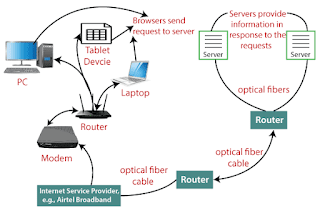What is IP Address
An IP address, short for Internet Protocol address, is a unique numerical label assigned to each device connected to a computer network that uses the Internet Protocol for communication. It serves two main purposes:
Identification: An IP address uniquely identifies a device on a network, similar to how a street address identifies a physical location. It enables devices to communicate with each other and ensures that data packets are routed correctly.
Location addressing: IP addresses are used to determine the destination of data packets within a network. They help in routing data from the source device to the intended recipient device.
There are two versions of IP addresses in use today: IPv4 (Internet Protocol version 4) and IPv6 (Internet Protocol version 6). IPv4 addresses are written as four sets of numbers separated by periods, such as "192.168.0.1". Each number in the set can range from 0 to 255. IPv6 addresses, on the other hand, are written as eight sets of alphanumeric characters separated by colons, such as "2001:0db8:85a3:0000:0000:8a2e:0370:7334". IPv6 was introduced to address the limited number of available IPv4 addresses and provides a much larger address space.
IP addresses can be dynamically assigned (through DHCP) or statically assigned (manually configured). They can be public, meaning they are accessible from the internet, or private, used within local networks such as home or office networks.
It's worth noting that IP addresses are crucial for devices to communicate over the internet, allowing data to be sent and received across networks worldwide.
In Hindi given below
एक आईपी एड्रेस, इंटरनेट प्रोटोकॉल एड्रेस का संक्षिप्त रूप, एक अद्वितीय संख्यात्मक लेबल है जो कंप्यूटर नेटवर्क से जुड़े प्रत्येक डिवाइस को सौंपा जाता है जो संचार के लिए इंटरनेट प्रोटोकॉल का उपयोग करता है। इसके दो मुख्य उद्देश्य हैं:
पहचान: एक आईपी पता विशिष्ट रूप से नेटवर्क पर एक डिवाइस की पहचान करता है, उसी तरह जैसे एक सड़क का पता किसी भौतिक स्थान की पहचान करता है। यह उपकरणों को एक दूसरे के साथ संचार करने में सक्षम बनाता है और यह सुनिश्चित करता है कि डेटा पैकेट सही ढंग से रूट किए गए हैं।
स्थान पता: आईपी पते का उपयोग नेटवर्क के भीतर डेटा पैकेट के गंतव्य को निर्धारित करने के लिए किया जाता है। वे स्रोत डिवाइस से इच्छित प्राप्तकर्ता डिवाइस तक डेटा रूट करने में मदद करते हैं।
आज आईपी पते के दो संस्करण उपयोग में हैं: आईपीवी4 (इंटरनेट प्रोटोकॉल संस्करण 4) और आईपीवी6 (इंटरनेट प्रोटोकॉल संस्करण 6)। IPv4 पते को अवधियों द्वारा अलग किए गए संख्याओं के चार सेटों के रूप में लिखा जाता है, जैसे "192.168.0.1"। सेट में प्रत्येक संख्या 0 से 255 तक हो सकती है। दूसरी ओर, IPv6 पते को कोलन द्वारा अलग किए गए अल्फ़ान्यूमेरिक वर्णों के आठ सेट के रूप में लिखा जाता है, जैसे "2001:0db8:85a3:0000:0000:8a2e:0370:7334 ". IPv6 को उपलब्ध IPv4 पतों की सीमित संख्या को संबोधित करने के लिए पेश किया गया था और यह बहुत बड़ा पता स्थान प्रदान करता है।
आईपी पते को गतिशील रूप से असाइन किया जा सकता है (डीएचसीपी के माध्यम से) या स्थिर रूप से असाइन किया जा सकता है (मैन्युअल रूप से कॉन्फ़िगर किया जा सकता है)। वे सार्वजनिक हो सकते हैं, जिसका अर्थ है कि वे इंटरनेट से पहुंच योग्य हैं, या निजी, घर या कार्यालय नेटवर्क जैसे स्थानीय नेटवर्क के भीतर उपयोग किए जाते हैं।
यह ध्यान देने योग्य है कि इंटरनेट पर संचार करने के लिए उपकरणों के लिए आईपी पते महत्वपूर्ण हैं, जिससे दुनिया भर के नेटवर्क पर डेटा भेजा और प्राप्त किया जा सकता है।

Comments
Post a Comment